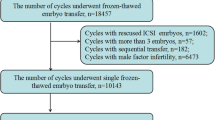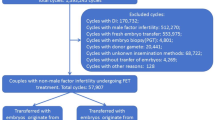Abstract
A twin pregnancy with complete hydatidiform mole (HM) and preterm birth of a normal female infant after intracytoplasmic sperm injection (ICSI) conception was experienced. ICSI due to severe oligozoospermia was performed on three ova, and three embryos with confirmed two proneclei (2PN) were subsequently transferred to the uterus. At 7 weeks of gestation, molar pregnancy as well as a viable fetus was recognized. At 33 weeks, the pregnancy was terminated due to preterm labor. Dichorionic pregnancy consisting of a normal fetus and placenta in one chorionic membrane and complete HM in the other was recognized. Cytomolecular analysis indicated that the complete HM genome was derived from duplication of a single sperm, and a normal neonate was from biparental genomes. It should be noted that ICSI can avoid incomplete HM (mostly triploid) due to multi-sperm fertilization but might not be able to avoid complete HM (paternal diploid) although such a risk is very low. This is the second report of this condition and is accompanied by the first well-described molecular analysis.
Similar content being viewed by others
Log in or create a free account to read this content
Gain free access to this article, as well as selected content from this journal and more on nature.com
or
References
Fisher RA, Khatoon R, Paradinas FJ, Roberts AP, Newlands ES (2000) Repetitive complete hydatidiform mole can be biparental in origin and either male or female. Hum Reprod 15:594–598
Jacobs PA, Szulman AE, Funkhouser J, Matsuura JS, Wilson CC (1982) Human triploidy: relationship between parental origin of the additional haploid complement and development of partial hydatidiform mole. Ann Hum Genet 46:223–231
Jones WB, Lauersen NH (1975) Hydatidiform mole with coexistent fetus. Am J Obstet Gynecol 122:267–272
Kajii T, Ohama K (1977) Androgenetic origin of hydatidiform mole. Nature 268:633–634
Matsui H, Sekiya S, Hando T, Wake N, Tomoda Y (2000) Hydatidiform mole coexistent with a twin live fetus: a national collaborative study in Japan. Hum Reprod 15:608–611
McDonald TW, Ruffolo EH (1983) Modern management of gestational trophoblastic disease. Obstet Gynecol Surv 38:67–83
Pal L, Toth TL, Leykin L, Isaacson KB (1996) High incidence of triploidy in in-vitro fertilized oocytes from a patient with a previous history of recurrent gestational trophoblastic disease. Hum Reprod 11:1529–1532
Petignat P, Senn A, Hohlfeld P, Blant SA, Laurini R, Germond M (2001) Molar pregnancy with a coexistent fetus after intracytoplasmic sperm injection. A case report. J Reprod Med 46:270–274
Reubinoff BE, Lewin A, Verner M, Safran A, Schenker JG, Abeliovich D (1997) Intracytoplasmic sperm injection combined with preimplantation genetic diagnosis for the prevention of recurrent gestational trophoblastic disease. Hum Reprod 12:805–808
Ruiz-Casares E, Henriques-Gil N, Opera M, Fernandez-Pacheco RP, Aguaron A (2001) Molecular analysis of a gestation consisting of a complete hydatidiform mole and normal dizygotic twin. J Reprod Med 46:1041–1045
Acknowledgements
We kindly express our gratitude to Ms. Tamae Hanai for her excellent technical assistance.
Author information
Authors and Affiliations
Corresponding author
Rights and permissions
About this article
Cite this article
Hamanoue, H., Umezu, N., Okuda, M. et al. Complete hydatidiform mole and normal live birth following intracytoplasmic sperm injection. J Hum Genet 51, 477–479 (2006). https://doi.org/10.1007/s10038-006-0388-3
Received:
Accepted:
Published:
Issue date:
DOI: https://doi.org/10.1007/s10038-006-0388-3
Keywords
This article is cited by
-
Twin pregnancy with a complete hydatidiform mole and co-existent live fetus: two case reports and review of the literature
Archives of Gynecology and Obstetrics (2009)
-
Twin pregnancy with a complete hydatidiform mole and surviving co-existent fetus
Archives of Gynecology and Obstetrics (2008)



